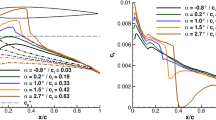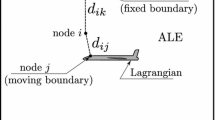Abstract
The aerodynamic performance of a wing mounting a simple unconventional box winglet are analyzed in detail by CFD simulations. The decomposition of the computed drag in its irreversible (viscous) and reversible (lift-induced) components by a far field drag breakdown method allows for the determination of the span efficiency, not a trivial task in the case of viscous flow. The aerodynamic performance are compared with the ones obtained in case of a simple standard winglet and without any tip appendices.












Similar content being viewed by others
Abbreviations
-
 :
: -
Wing aspect ratio
- b :
-
Wingspan
- \(b_w\) :
-
Winglet wingspan
- c :
-
Chord
- \(C_D\) :
-
Drag coefficient
- \(C_{D_i}\) :
-
Lift-induced drag coefficient
- \(C_{D_i}^{\mathrm {ref}}\) :
-
Minimum lift-induced drag coefficient
- \(C_{D_i}^{\mathrm {WS}}\) :
-
Lift-induced drag coefficient for a generic wing system
- \(C_{D_{\mathrm {far}}}\) :
-
Far field drag coefficient
- \(C_{D_{\mathrm {irr}}}\) :
-
Irreversible drag coefficient
- \(C_{D_{\mathrm {near}}}\) :
-
Near field drag coefficient
- \(C_{D_{\mathrm {rev}}}\) :
-
Reversible drag coefficient
- \(C_f\) :
-
Skin friction coefficient
- \(C_L\) :
-
Lift coefficient
- \(C_{L_{\mathrm {near}}}\) :
-
Near field lift coefficient
- \(C_p\) :
-
Pressure coefficient
- \(D_i\) :
-
Lift-induced drag
- \(D_i^{\mathrm {ref}}\) :
-
Minimum lift-induced drag
- \(D_{\mathrm {far}}\) :
-
Far field drag
- \(D_{\Delta s}\) :
-
Entropy drag
- \(D_{v}\) :
-
Viscous drag
- \(D_{w}\) :
-
Wave drag
- \(D_{sp}\) :
-
Spurious drag
- \(\Delta s\) :
-
Entropy variation
- E :
-
Aerodynamic efficiency
- \(h_w\) :
-
Winglet height
- M :
-
Mach number
- \(\mathbf {n}\) :
-
Unit normal vector
- p :
-
Pressure
- R :
-
Gas constant
- Re :
-
Reynolds number
- S :
-
Reference wing surface
- \(\mathbf {V}\) :
-
Local velocity vector
- \(\mathbb {V}\) :
-
Vertical aspect ratio
- \(\alpha \) :
-
Angle of attack
- \(\varepsilon \) :
-
Optimal aerodynamic efficiency ratio
- \(\Phi \) :
-
Flow potential
- \(\gamma \) :
-
Ratio of specific heats
- \(\psi \) :
-
Stream function
- \(\rho \) :
-
Density
- \(\sigma \) :
-
Source strength
- \(\zeta _x\) :
-
Vorticity component in free-stream direction
- \(\infty \) subscript:
-
Free-stream conditions
- BLI:
-
Boundary layer ingestion
- BW:
-
Box winglet
- BWD:
-
Best winglet design
- CFD:
-
Computational fluid-dynamics
- DEP:
-
Distributed electric propulsion
- NW:
-
No winglet
- SW:
-
Standard winglet
- WBW:
-
Wing + box winglet
- WFR:
-
Winglet fundamental rectangle
- WPP:
-
Winglet primary properties
References
Bows, A.: Aviation and climate change: confronting the challenge. Aeronaut. J. 1968(114), 459–468 (2010)
Flightpath 2050: Europe’s Vision for Aviation tech. rep. (European Commission, 2011)
Plas, A et al. Performance of a Boundary Layer Ingesting (BLI) Propulsion System in 45th AIAA Aerospace Sciences Meeting and Exhibit (2007). https://doi.org/10.2514/6.2007-450
Felder, J., Kim, H., Brown, G. & Kummer, J. An examination of the effect of boundary layer ingestion on turboelectric distributed propulsion systems in 49th AIAA aerospace sciences meeting including the new horizons forum and aerospace exposition (2011). https://doi.org/10.2514/6.2011-300
Hall, D. K. et al. Boundary layer ingestion propulsion benefit for transport aircraft. J. Prop. Power 33, 1118–1129. https://doi.org/10.2514/1.B36321 (2017)
Stoll, A. M., Bevirt, J., Moore, M. D., Fredericks, W. J. & Borer, N. K. Drag Reduction Through Distributed Electric Propulsion in 14th AIAA Aviation Technology, Integration, and Operations Conference (2014). https://doi.org/10.2514/6.2014-2851
Borer, N. K. et al. Design and performance of the NASA SCEPTOR distributed electric propulsion flight demonstrator in 16th AIAA aviation technology, integration, and operations conference (2016). https://doi.org/10.2514/6.2016-3920
Keller, D. Towards higher aerodynamic efficiency of propeller-driven aircraft with distributed propulsion. CEAS Aeronaut. J. (2021)
Deere, K. A. et al. in 35th AIAA Applied Aerodynamics Conference (). https://doi.org/10.2514/6.2017-3923
Hasan, Y., Sachs, F., Dauer, J.: Preliminary design study for a future unmanned cargo aircraft configuration. CEAS Aeronaut. J. 9, 571–586 (2018)
Prandtl, L. Induced drag of multiplanes tech. rep. (NACA, 1924)
J. Wolkovitch, J. The joined wing—an overview. J. Aircr. 23, 161–178. https://doi.org/10.2514/3.45285 (1986)
Cavallaro, R., Demasi, L.: Challenges, ideas and innovations of joined- wing configurations: a concept from the past, an opportunity for the future. Prog. Aerosp. Sci. 87, 1–94 (2016)
Russo, L., Tognaccini, R. & Demasi, L. Box wing and induced drag: compressibility effects in subsonic and transonic regimes. AIAA J. 58, 2398–2413. https://doi.org/10.2514/1.J059080 (2020)
Hemke, P. E. Drag of wings with end plates (US Government Printing Office, 1927)
Mangler, W. The lift distribution of wings with end plates tech. rep. TN- 856 (NACA, 1938)
Whitcomb, R. T. A Design approach and selected wind tunnel results at high subsonic speeds for wing-tip mounted winglets tech. rep. TND- 8260 (NASA, 1976)
Kroo, I. in VKI lecture series on Innovative Configurations and Advanced Concepts for Future Civil Aircraft (Von Karman Institute Lecture Series, 2005)
McLean, D. Wingtip devices: what they do and how they do it in boeing performance and flight operations engineering conference (2005)
Ning, S. A. & Kroo, I. Multidisciplinary considerations in the design of wings and wing tip devices. J. Aircr. 47, 534–543. https://doi.org/10.2514/1.41833 (2010)
Delavenne, M., Barriety, B., Vetrano, F., Ferrand, V., Salaun, M.: Assessment of the efficiency of an active winglet concept for a long-range aircraft. CEAS Aeronaut. J. 11, 971–990 (2020)
Allen, J. B. Articulating winglets US Patent 5,988,563 (1999)
Gratzer, L. B. Blended winglet US Patent 5,348,253 (1994)
Gratzer, L. B. Spiroid-tipped wing US Patent 5,102,068 (1992)
Gratzer, L. B. Split blended winglet US Patent 8,944,386 (2015)
Demasi, L., Dipace, A., Monegato, G. & Cavallaro, R. Invariant formulation for the minimum induced drag conditions of nonplanar wing systems. AIAA J. 52, 2223–2240. https://doi.org/10.2514/1.J052837 (2014)
Demasi, L., Monegato, G., Rizzo, E., Cavallaro, R., Dipace, A.: Minimum induced drag theorems for joined wings, closed systems, and generic biwings: applications. J. Optim. Theory Appl. 169, 236–261 (2015)
Demasi, L., Monegato, G., Dipace, A. & Cavallaro, R. Minimum induced drag theorems for joined wings, closed systems, and generic biwings: theory. J. Optim. Theory Appl. 169, 200–235. https://doi.org/10.1007/s10957-015-0849-y (2016)
Demasi, L., Monegato, G. & Cavallaro, R. Minimum induced drag theorems for multiwing systems. AIAA J. 55, 3266–3287. https://doi.org/10.2514/1.J055652 (2017)
Damasi, L., Monegato, G., Cavallaro, R. & Rybarczyk, R. Minimum Induced Drag Conditions for Winglets: the Best Winglet Design Concept in AIAA Scitech 2019 Forum (2019). https://doi.org/10.2514/6.2019-2301
Munk, M. The Minimum Induced Drag of Aerofoils tech. rep. (NACA, 1923)
Anderson, J. D. Fundamentals of Aerodynamics (McGraw-Hill, 2001)
Fan, Y. & Li, W. Review of far-field drag decomposition methods for aircraft design. J. Airc. 56, 11–21. https://doi.org/10.2514/1.C034781 (2019)
Méheut, M., Bailly, D.: Drag-breakdown methods from wake measurements. AIAA J. 46, 847–862 (2015)
Oswatitsch, K. Gas Dynamics 207-210 (Academic Press, 1956). Aerotecnica Missili & Spazio
Ueno, M., Yamamoto, K., Tanaka, K., Murayama, M., Tognaccini, R.: Far-field drag analysis of NASA common research model simulation. J. Aircr. 50, 388–397 (2013)
Mele, B., Russo, L., Tognaccini, R.: Drag bookkeeping on an aircraft with riblets and NLF control. Aerosp. Sci. Technol. 98, 105714 (2020)
Wu, J. Z., Liu, L. Q. & Liu, T. S. Fundamental theories of aerodynamic force in viscous and compressible complex flows. Prog. Aerosp. Sci. (2018)
Saffman, P.G.: Vortex Dynamics. Cambridge University Press, Cambridge, UK (1992)
Paparone, L. & Tognaccini, R. Computational Fluid Dynamics-Based Drag Prediction and Decomposition. AIAA Journal 41, 1647–1657. https://doi.org/10.2514/2.7300 (2003)
Destarac, D. & van der Vooren, J. Drag/thrust analysis of jet-propelled transonic transport aircraft; Definition of physical drag components. Aerosp. Sci. Technol. 8, 545–556 (2004)
Fournis, C., Bailly, D. & Tognaccini, R. in AIAA aviation 2021 forum (). https://doi.org/10.2514/6.2021-2554
Lanzetta, M., Mele, B. & Tognaccini, R. Advances in aerodynamic drag extraction by far field methods. J. Airc. 52 (2015)
Maskell, E. C. Progress towards a method for the measurement of the components of the drag of a wing of finite span tech. rep. Technical Report No. 72232 (RAE, United Kingdom, 1972)
Kusunose, K. A wake integration method for airplane drag prediction. In: The 21st century COE program international COE of flow dynamics lecture series (2005)
Economon, T., Palacios, F., Copeland, S., Lukaczyk, T., Alonso, J.: SU2: an open-source suite for multiphysics simulation and design. AIAA J. 54, 828–846 (2016)
Demasi, L., Monegato, G., Cavallaro, R., Rybarczyk, R.: Minimum induced drag conditions for truss-braced wings. AIAA J. 56, 4669–4684 (2018)
Acknowledgements
An earlier version of this work was presented at the AIAA Aviation 2021 Forum, paper AIAA 2021-2544 (“Best Winglet of Minimum Induced Drag: Viscous and Compressible Flow Predictions”).
Author information
Authors and Affiliations
Corresponding author
Additional information
Publisher's Note
Springer Nature remains neutral with regard to jurisdictional claims in published maps and institutional affiliations.
Appendix A
Appendix A
In the following pages the results of the grid convergence analyses performed for the configurations analyzed are collected.
The number of cells of the fine grid level (LVL1), whose results were described in the previous sections was divided 2 and 4 times to obtain a medium (LVL2) and a coarse (LVL4) grid level. The near-field lift and drag coefficients against the grid levels are plotted in Fig. 13 for the BW configuration, Fig. 14 for the NW configuration and Fig. 15 for the SW configuration. Figure 14 clearly shows that the results for the simplest NW geometry are already converged at LVL2. On the contrary, this result is not clear for the more complex geometries. Therefore, in the case of BW configuration, an additional superfine grid level (LVL0.5) has been built-up doubling the number of cells of LVL1; the results of LVL0.5 show that a satisfactory convergence was indeed obtained by LVL1.
Rights and permissions
About this article
Cite this article
Russo, L., Saetta, E., Tognaccini, R. et al. Aerodynamic Analysis of a Box Winglet: Viscous and Compressible Flow Predictions. Aerotec. Missili Spaz. 101, 321–334 (2022). https://doi.org/10.1007/s42496-022-00125-6
Received:
Revised:
Accepted:
Published:
Issue Date:
DOI: https://doi.org/10.1007/s42496-022-00125-6





 :
:

